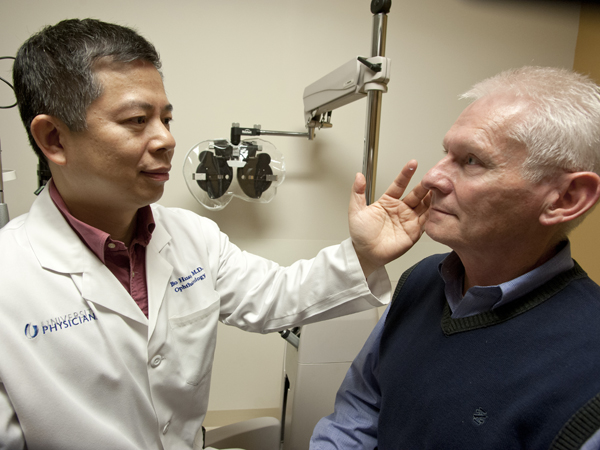Contact lens care matters – better safe than sorry

Dr. Bo Huang, UMMC associate professor of ophthalmology and director of cornea service, specializes in cornea, external diseases and refractive surgery. He is board certified by the American Board of Ophthalmology. As part of national Contact Lens Health Week, Huang provides good information to contact lens wearers on how to keep their eyes healthy.

During the contact lens fitting examination, your ophthalmologist will give instructions about how to care for the lenses properly and recommend solutions to be used. Maintaining good contact lens hygiene will significantly decrease the risk of eye infection.
The main points contact lens wearers should remember:
- Always wash and dry your hands before handling contact lenses.
- Carefully and regularly clean contact lenses as directed by your eye doctor. Rub the contact lenses with your fingers, and rinse thoroughly before soaking lenses overnight in sufficient multi-purpose solution to completely cover the lens.
- Store lenses in the proper lens storage case and replace your case every three months or sooner. Clean the case after each use, and keep it open and dry between cleanings.
- Use only products recommended by your eye doctor to clean and disinfect your lenses. Saline solution and rewetting drops are not designed to disinfect lenses.
- Only fresh solution should be used to clean and store contact lenses. Never re-use old solution. Contact solution must be changed according to the manufacturer’s recommendations.
- Always follow the recommended contact lens replacement schedule prescribed by your eye doctor.
- Remove contact lenses before swimming or entering a hot tub.
- See your eye doctor for your regularly scheduled contact lens and eye examination.
There are a number of complications associated with contact lens wear. One of the most avoidable complications arises when people sleep with their lenses in their eyes. There is a significantly higher incidence of severe corneal infection in wearers who sleep in contact lenses compared with those who only use lenses during the waking hours.
In addition to infections, there are other problems to watch for in contact wearers. Red eye, which can result from lens wear, has a variety of origins, including an improper fit, lens deposits, damaged lenses, oxygen deficiency, an allergic reaction to lens care solution ingredients, ocular allergy and dry eye.
The best way to prevent infection is the proper use of contact lens solutions. Some patients do not clean their lenses sufficiently at night before placing them in the cases. Or, they reuse or add to the solution remaining in the lens case, which should be a fresh solution every day.
To make a doctor’s appointment with University Physicians’ Department of Ophthalmology, call (601) 984-5016.


